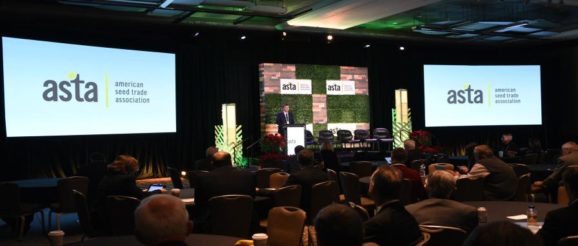Hemp Genetics CEO: Stable THC Levels Will Come With Breeding Innovation (OPINION) – Greenhouse Grower

Photo Courtesy – Chuck Zimmerman/AgWired.com
Society at-large is literally bursting at the seams with interest in hemp and CBD, and the traditional, John Deere-tractor-and-a-bag-of-GMO-seed segment of the agriculture world has not been spared.
You can jump on your Google machine and pull up report after report of long-downtrodden ag regions known for legacy production of tobacco and cotton and other commoditized, low value crops turning acres over to hemp in large numbers. The Carolinas are a hotbed for this type of thing, from what we’re hearing anyways.
But really it’s happening all over the countryside, and it’s not going to stop anytime soon, not with the most conservative estimates pitting an acre of high-CBD hemp biomass fetching anywhere from $250 to $500 at market (after accounting for production costs, the bulk of which are to pay expensive hand labor crews to harvest the plants).
Comparably, soy farmers that have the benefit of large scale, mechanized planting and harvesting equipment were making around $160 per acre average on their crop back in 2012, whereas today they are reportedly taking a $20 an acre loss on average on production.
That’s largely the result of the market-depressing 2019 commodities Trade Wars, which has many farmers looking to hemp as a way to get themselves and the family farm out of the roller coaster international trade market and it’s wild fluctuations.
And let’s not even mention the horrible spring planting season this past year for most commodity crops, where a ton of acres didn’t even get planted and remained fallow for all of 2019.
It’s all a long way of making the point that, you can’t really blame a lot of these farmers for looking to hemp to change their fortunes. Farming is, after all, a business at the end of the day.
But, I digress. Let’s get to the point of this article:
Long the gathering place for corn, soybean, sorghum, and other large-scale, commercial crop breeders and researchers working both for and with the multinational seed companies, this year the American Seed Trade Association (ASTA) held a “Hemp and Seed Opportunities & Challenges” session at the group’s annual winter meeting in downtown Chicago, IL.
Those in attendance that mid-December afternoon report there was “lots of interest” in the session. I was mostly interested in hearing what one featured speaker, New West Genetics CEO Wendy Mosher, had to say to the group, which I found a recording of on ag media veterans Chuck and Cindy Zimmerman’s AgWired site (Thanks, Chuck and Cindy!).
The reason seeing Mosher’s name on the agenda peaked my interest: Growers we’ve come to know in this space have reported the genetics in hemp (and legal cannabis) as uneven performing at best, often generally unreliable for the marketed phenotypes promised and, at worst, either non-germinating or non-compliant on the 0.3% THC content requirement established in USDA’s now-infamous Interim Final Rulemaking.
As CEO Mosher herself, an expert in the field, pointed out in her address to ASTA, there’s just so little replicated, independent breeding data on all of these genetic varieties and crosses and hybrid strains of cannabis sativa – she describes the current hemp breeding world as “still in the 1950s” compared to other technologically advanced ag seed segments like corn and soy.
Anyways, the reason I was interested in hearing from Mosher is I had heard of her outfit, New West Genetics, before. The name kept coming up in conversations with growers and in web searches as we did our preliminary homework on the genetic side of the hemp market.
New West is notable in the hemp genetics game and should be on any prospective hemp growers radar for many reasons, perhaps chiefly among them having the first US-bred commercial variety of hemp (NWG ELITE) to be earn classification as a “certified variety” by the Association of Seed Certifying Agencies (AOSCA). I would also add that they’ve assembled a top-notch team of traditional and non-traditional breeding expertise, which you can check out here. I’m no grower myself, but if I were, these are the type of genetics providers I’d look to work with.
Mosher’s ASTA Talk
The hemp seed breeder CEO started off her address to ASTA with a plea for more participation from the ag seed industry, saying hemp breeding “desperately needs the seed industries’ expertise and professionalism.”
“We need the seed industry to be participating so we can keep things as optimized as we can,” she added.
Currently, she says, her group New West Genetics is focused on “creating mechanized, stable varieties for the modern hemp market, which is pretty much exclusively for the flower and processing market, with some modest demand (for the grain).”
With CBD based-products projected to be a $1.8 billion industry by 2022, and consumers becoming more aware of the high Omega 3 to low Omega 6 ratios in hemp – Mosher says it’s the closest ratio to fish oil found in a plant-based formulation – the hemp market seems like it is here to stay for the foreseeable future, and opportunity for farmers on both the flower and the grain side abound.
Mosher had one particular point that I found fascinating, mostly because it debunked one of the long-held beliefs I had come to take as fact, that the THC percentage levels of finished hemp flower were the direct result of environmental factors like heat stress, light, climate, etc.
“All of the research that we have done thus far, and, again, it’s initial, but all of it has proven the exact opposite,” Mosher says. “We’ve found that the genetics are controlling a little over 80% of the traits of the cannabinoids, as opposed to something like yield which is more 50-50. This is great news, because with well-bred seed we can create stable THC content across regions. And, of course, CBD (levels) as well.”
Mosher also says New West has uncovered in its research trials from 2019 that “some of the major commercial varieties on the market are not compliant (with the 0.3% THC requirement).”
Yet, there is good news on the breeding side as well.
“We want to find a balance between the two markets (flower and grain) and make mechanically harvestable varieties that are also enhanced for CBD,” she says. “And you’re going to see enhanced CBD varieties that are diaceous next year, in 2020. We’ve got them coming to market, we’ve just got to bulk up (the numbers).”
No Objection to 0.3%
New West is perhaps unlike some others I’ve encountered in the industry in that the group is not actively lobbying for a loosening of the 0.3% THC or lower requirement in the IFR, or asking for an allowance of up to 1% THC as has become common during the USDA comment period, which was recently extended to Jan. 30.
While Mosher admits the requirement is “the greatest risk for producers, from our perspective,” she believes it can be managed and even conquered consistently by sourcing certified, replicated genetics.
“Right now the way it (testing) works is you estimate about a 20-30 day window from maturity and you start to test for THC content, starting weekly and then as you see the THC content start to climb you start testing more frequently so you can catch it before it crosses the threshold,” she explains. “We see that as a result of using non-compliant genetics, but everyone in the industry sees it a little differently.”
“The consequences of missing that (0.3%) window is severe, because if it happens your crop cannot enter the stream of commerce,” she adds. “This hasn’t been a huge deal up until this point because before the IFR not everybody was being tested, right? Now, they want every plot tested so it’s becoming more and more of a risk to not use compliant, proven genetics.”
In concluding her address to ASTA, Mosher stressed the need for a mechanized harvesting solution so growers can more economically harvest the crop, as well as a need for more education on the grain side as to using hemp grain and protein in animal feed, bedding, and other sustainable applications.
Matthew J. Grassi is the Technology Editor for Greenhouse Grower and American Vegetable Grower, both Meister Media Worldwide brands. See all author stories here.

